Liquidation Report: Examining Causes of Company Failures in Australia
VerifiedAdded on 2021/05/31
|10
|2171
|23
Report
AI Summary
This report delves into the topic of liquidation, exploring the reasons behind company closures and failures. It examines the cases of three major Australian companies: ABC Learning, OneTel, and HIH Insurance. The analysis highlights key factors contributing to liquidation, including unethical accounting practices, inability to manage debt, poor corporate governance, and fraudulent activities. The report discusses the specific issues faced by each company, such as incorrect balance sheet valuations, disclosure of price-sensitive information, and inadequate internal controls. The conclusion summarizes the common causes of liquidation and provides recommendations for improved financial management and corporate governance. The report emphasizes the crucial role of auditors in providing assurance regarding the accuracy of financial statements and the importance of ethical business practices to prevent company failures.

Paraphrase This Document
Need a fresh take? Get an instant paraphrase of this document with our AI Paraphraser
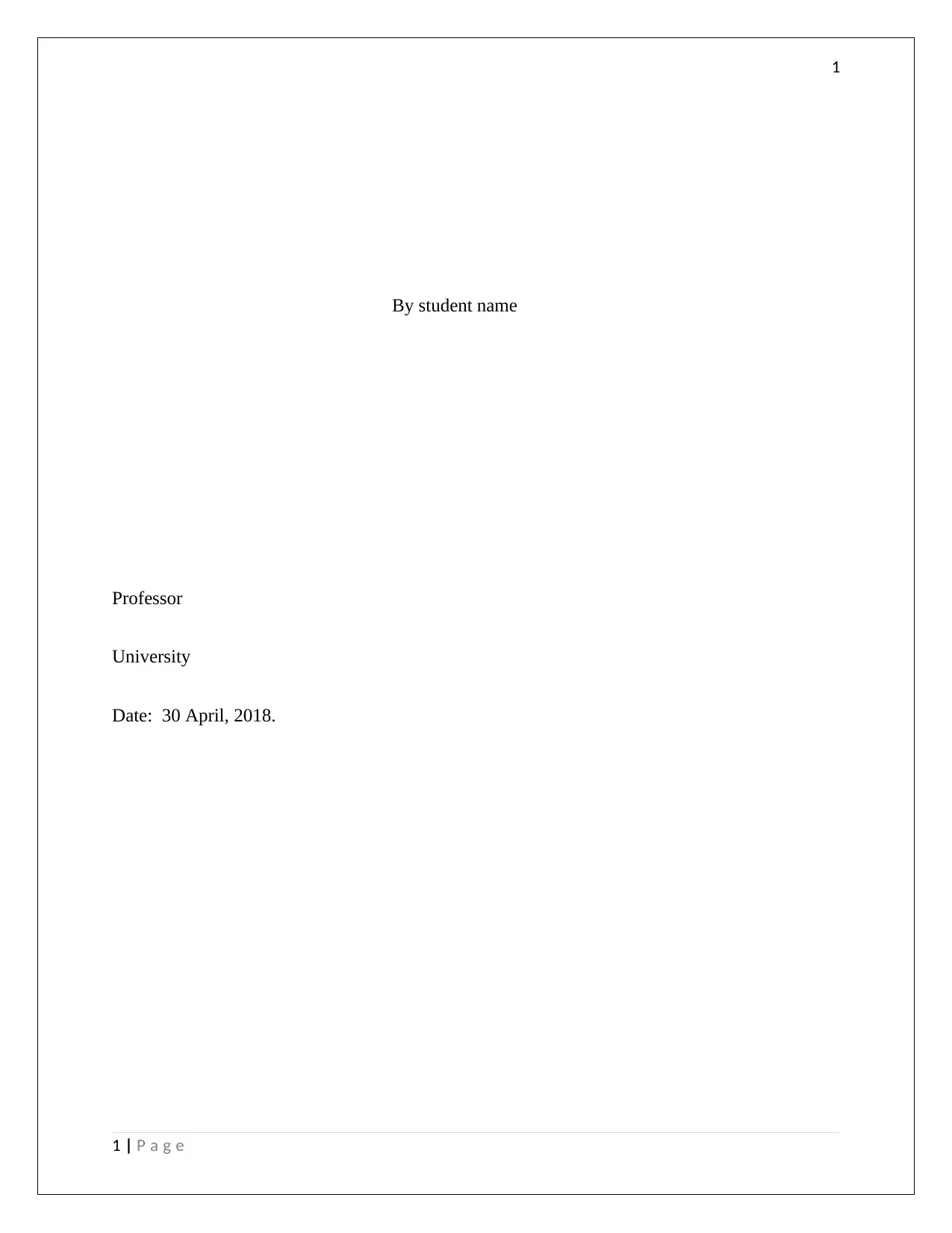
1
By student name
Professor
University
Date: 30 April, 2018.
1 | P a g e
By student name
Professor
University
Date: 30 April, 2018.
1 | P a g e
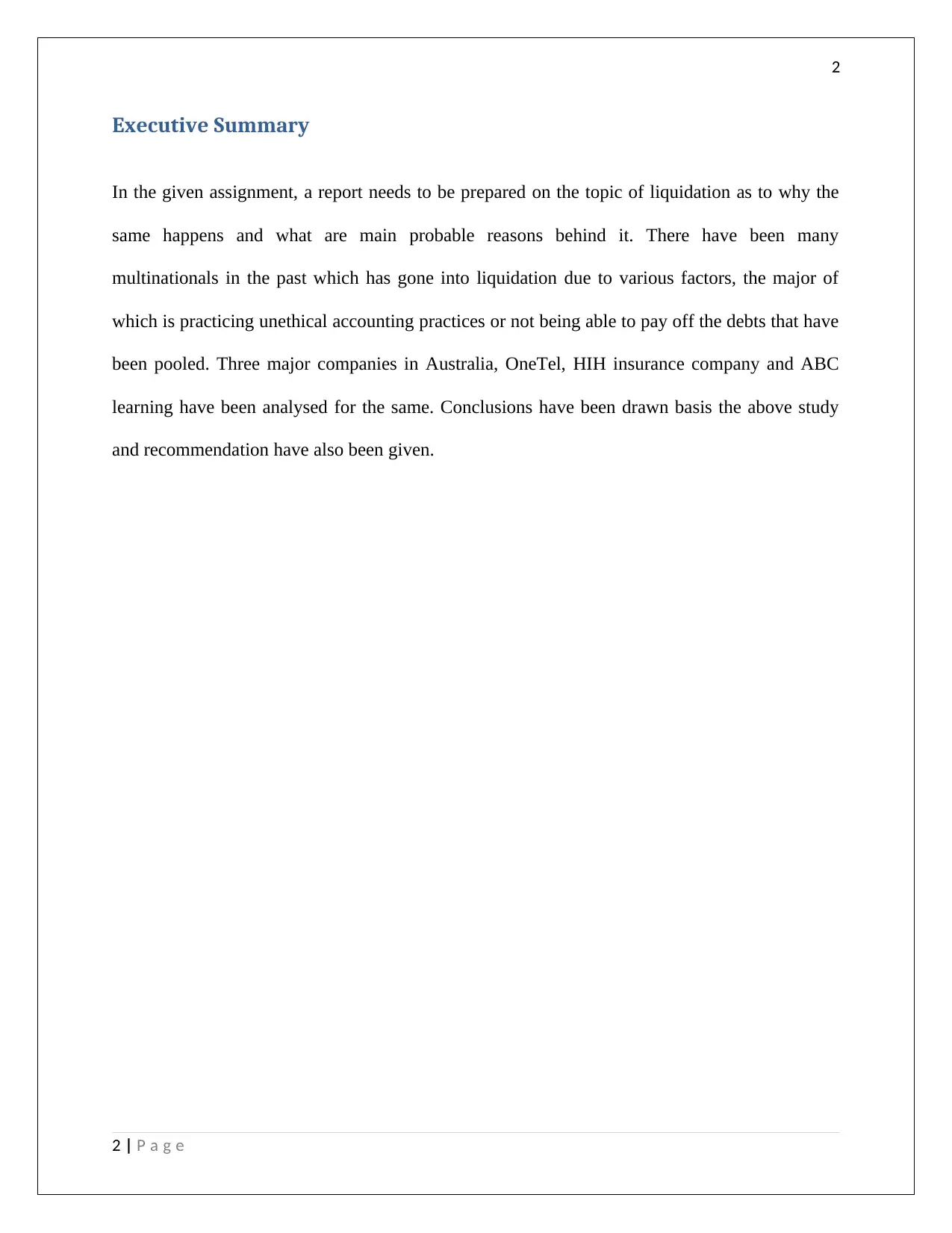
2
Executive Summary
In the given assignment, a report needs to be prepared on the topic of liquidation as to why the
same happens and what are main probable reasons behind it. There have been many
multinationals in the past which has gone into liquidation due to various factors, the major of
which is practicing unethical accounting practices or not being able to pay off the debts that have
been pooled. Three major companies in Australia, OneTel, HIH insurance company and ABC
learning have been analysed for the same. Conclusions have been drawn basis the above study
and recommendation have also been given.
2 | P a g e
Executive Summary
In the given assignment, a report needs to be prepared on the topic of liquidation as to why the
same happens and what are main probable reasons behind it. There have been many
multinationals in the past which has gone into liquidation due to various factors, the major of
which is practicing unethical accounting practices or not being able to pay off the debts that have
been pooled. Three major companies in Australia, OneTel, HIH insurance company and ABC
learning have been analysed for the same. Conclusions have been drawn basis the above study
and recommendation have also been given.
2 | P a g e
⊘ This is a preview!⊘
Do you want full access?
Subscribe today to unlock all pages.

Trusted by 1+ million students worldwide
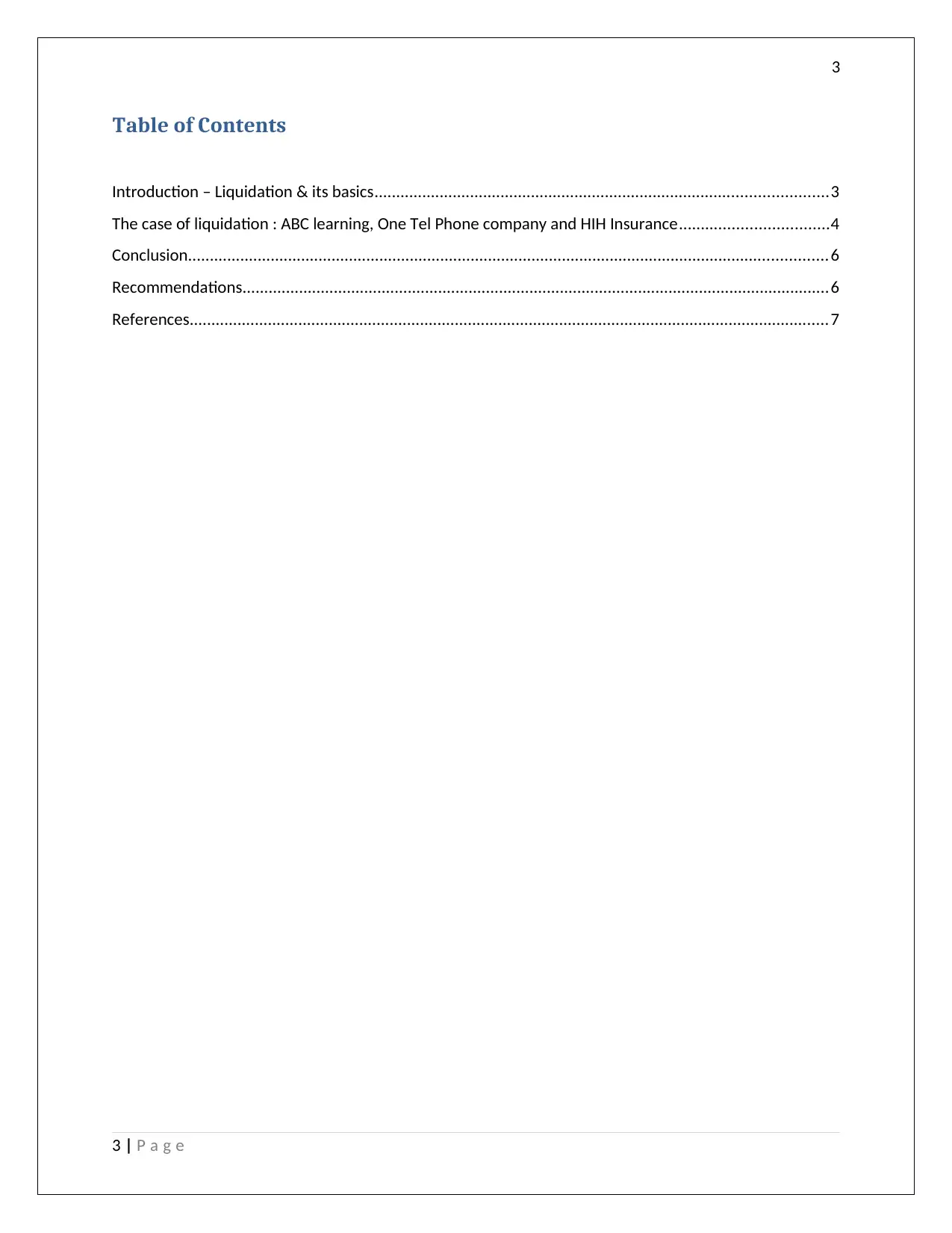
3
Table of Contents
Introduction – Liquidation & its basics........................................................................................................3
The case of liquidation : ABC learning, One Tel Phone company and HIH Insurance..................................4
Conclusion...................................................................................................................................................6
Recommendations.......................................................................................................................................6
References...................................................................................................................................................7
3 | P a g e
Table of Contents
Introduction – Liquidation & its basics........................................................................................................3
The case of liquidation : ABC learning, One Tel Phone company and HIH Insurance..................................4
Conclusion...................................................................................................................................................6
Recommendations.......................................................................................................................................6
References...................................................................................................................................................7
3 | P a g e
Paraphrase This Document
Need a fresh take? Get an instant paraphrase of this document with our AI Paraphraser
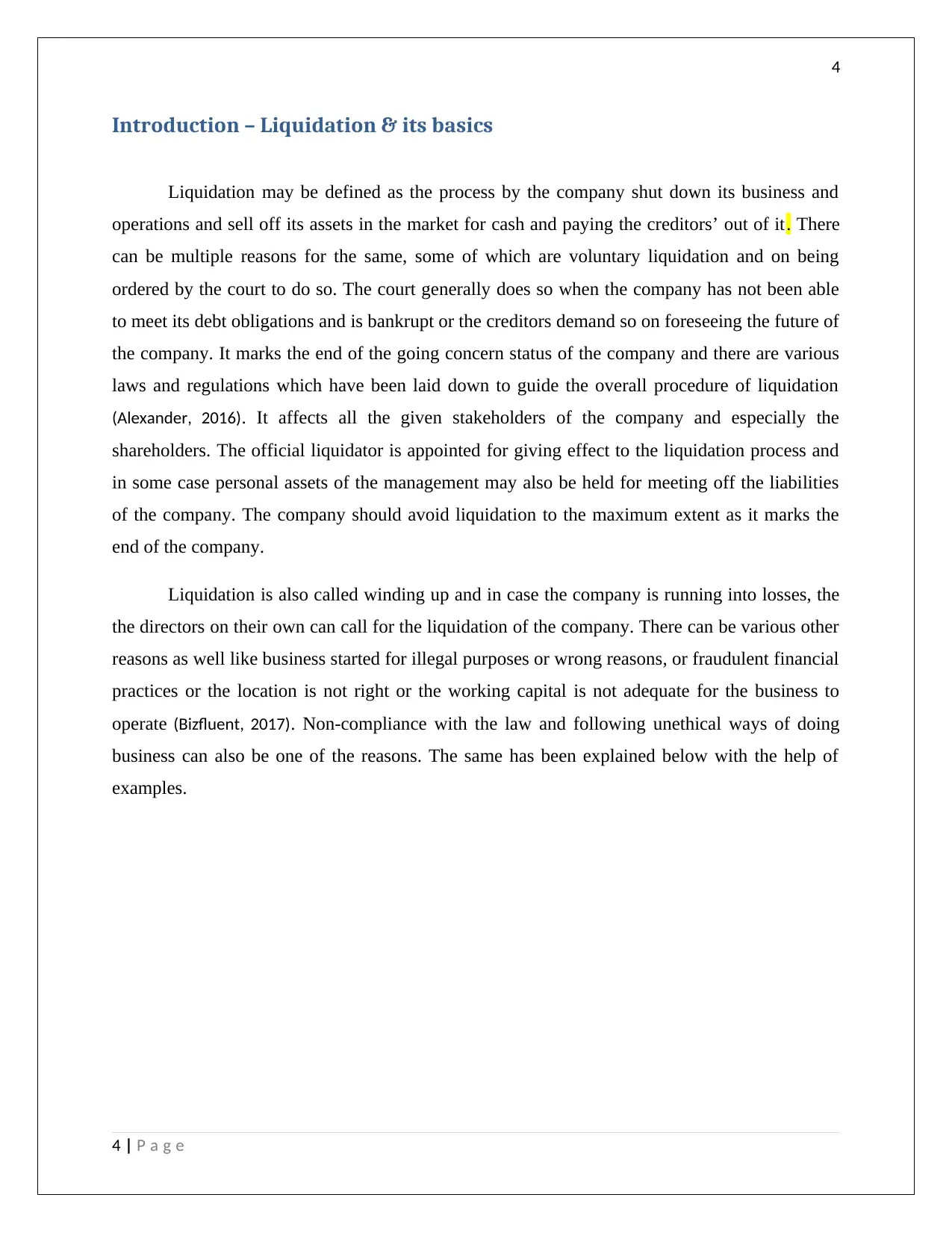
4
Introduction – Liquidation & its basics
Liquidation may be defined as the process by the company shut down its business and
operations and sell off its assets in the market for cash and paying the creditors’ out of it. There
can be multiple reasons for the same, some of which are voluntary liquidation and on being
ordered by the court to do so. The court generally does so when the company has not been able
to meet its debt obligations and is bankrupt or the creditors demand so on foreseeing the future of
the company. It marks the end of the going concern status of the company and there are various
laws and regulations which have been laid down to guide the overall procedure of liquidation
(Alexander, 2016). It affects all the given stakeholders of the company and especially the
shareholders. The official liquidator is appointed for giving effect to the liquidation process and
in some case personal assets of the management may also be held for meeting off the liabilities
of the company. The company should avoid liquidation to the maximum extent as it marks the
end of the company.
Liquidation is also called winding up and in case the company is running into losses, the
the directors on their own can call for the liquidation of the company. There can be various other
reasons as well like business started for illegal purposes or wrong reasons, or fraudulent financial
practices or the location is not right or the working capital is not adequate for the business to
operate (Bizfluent, 2017). Non-compliance with the law and following unethical ways of doing
business can also be one of the reasons. The same has been explained below with the help of
examples.
4 | P a g e
Introduction – Liquidation & its basics
Liquidation may be defined as the process by the company shut down its business and
operations and sell off its assets in the market for cash and paying the creditors’ out of it. There
can be multiple reasons for the same, some of which are voluntary liquidation and on being
ordered by the court to do so. The court generally does so when the company has not been able
to meet its debt obligations and is bankrupt or the creditors demand so on foreseeing the future of
the company. It marks the end of the going concern status of the company and there are various
laws and regulations which have been laid down to guide the overall procedure of liquidation
(Alexander, 2016). It affects all the given stakeholders of the company and especially the
shareholders. The official liquidator is appointed for giving effect to the liquidation process and
in some case personal assets of the management may also be held for meeting off the liabilities
of the company. The company should avoid liquidation to the maximum extent as it marks the
end of the company.
Liquidation is also called winding up and in case the company is running into losses, the
the directors on their own can call for the liquidation of the company. There can be various other
reasons as well like business started for illegal purposes or wrong reasons, or fraudulent financial
practices or the location is not right or the working capital is not adequate for the business to
operate (Bizfluent, 2017). Non-compliance with the law and following unethical ways of doing
business can also be one of the reasons. The same has been explained below with the help of
examples.
4 | P a g e
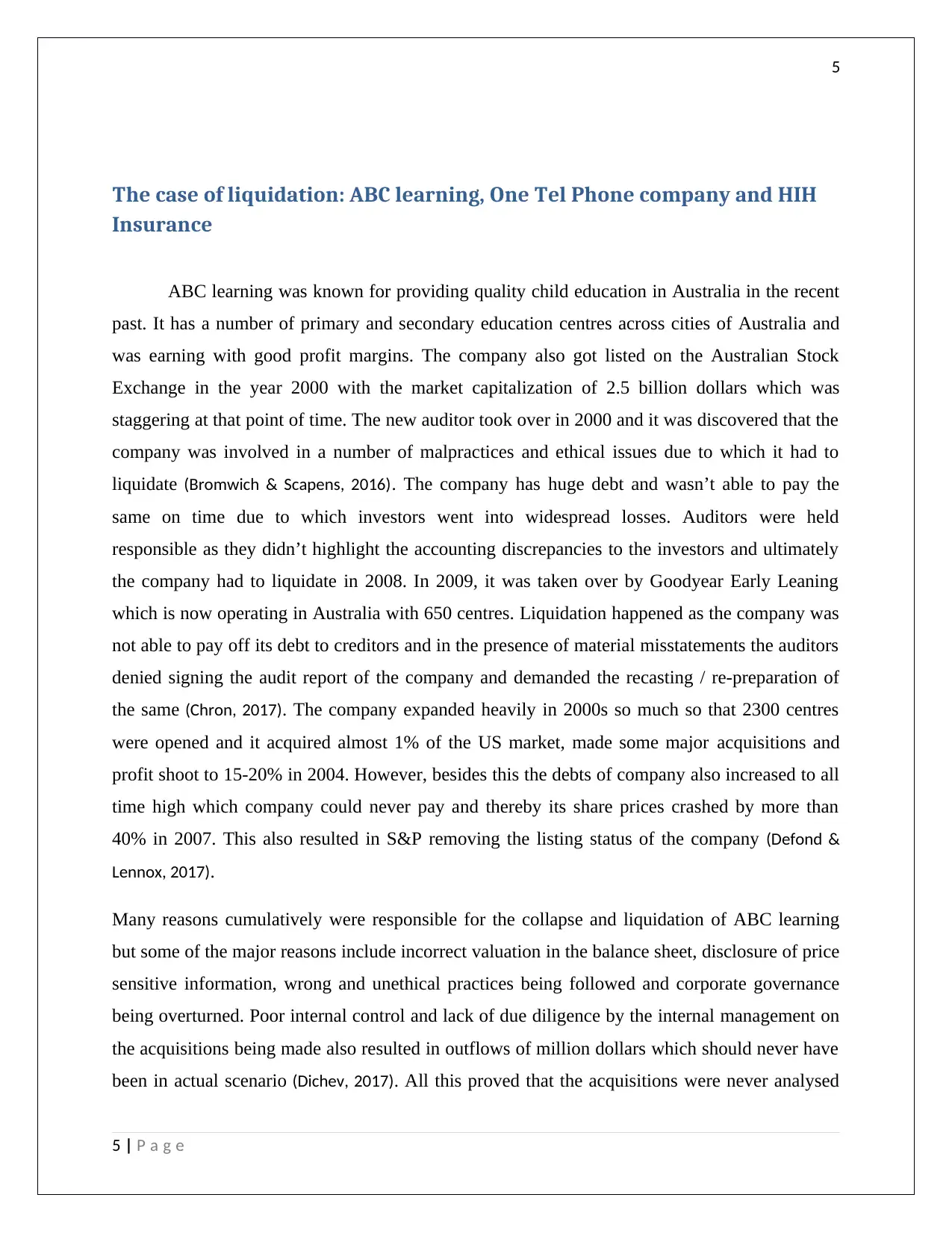
5
The case of liquidation: ABC learning, One Tel Phone company and HIH
Insurance
ABC learning was known for providing quality child education in Australia in the recent
past. It has a number of primary and secondary education centres across cities of Australia and
was earning with good profit margins. The company also got listed on the Australian Stock
Exchange in the year 2000 with the market capitalization of 2.5 billion dollars which was
staggering at that point of time. The new auditor took over in 2000 and it was discovered that the
company was involved in a number of malpractices and ethical issues due to which it had to
liquidate (Bromwich & Scapens, 2016). The company has huge debt and wasn’t able to pay the
same on time due to which investors went into widespread losses. Auditors were held
responsible as they didn’t highlight the accounting discrepancies to the investors and ultimately
the company had to liquidate in 2008. In 2009, it was taken over by Goodyear Early Leaning
which is now operating in Australia with 650 centres. Liquidation happened as the company was
not able to pay off its debt to creditors and in the presence of material misstatements the auditors
denied signing the audit report of the company and demanded the recasting / re-preparation of
the same (Chron, 2017). The company expanded heavily in 2000s so much so that 2300 centres
were opened and it acquired almost 1% of the US market, made some major acquisitions and
profit shoot to 15-20% in 2004. However, besides this the debts of company also increased to all
time high which company could never pay and thereby its share prices crashed by more than
40% in 2007. This also resulted in S&P removing the listing status of the company (Defond &
Lennox, 2017).
Many reasons cumulatively were responsible for the collapse and liquidation of ABC learning
but some of the major reasons include incorrect valuation in the balance sheet, disclosure of price
sensitive information, wrong and unethical practices being followed and corporate governance
being overturned. Poor internal control and lack of due diligence by the internal management on
the acquisitions being made also resulted in outflows of million dollars which should never have
been in actual scenario (Dichev, 2017). All this proved that the acquisitions were never analysed
5 | P a g e
The case of liquidation: ABC learning, One Tel Phone company and HIH
Insurance
ABC learning was known for providing quality child education in Australia in the recent
past. It has a number of primary and secondary education centres across cities of Australia and
was earning with good profit margins. The company also got listed on the Australian Stock
Exchange in the year 2000 with the market capitalization of 2.5 billion dollars which was
staggering at that point of time. The new auditor took over in 2000 and it was discovered that the
company was involved in a number of malpractices and ethical issues due to which it had to
liquidate (Bromwich & Scapens, 2016). The company has huge debt and wasn’t able to pay the
same on time due to which investors went into widespread losses. Auditors were held
responsible as they didn’t highlight the accounting discrepancies to the investors and ultimately
the company had to liquidate in 2008. In 2009, it was taken over by Goodyear Early Leaning
which is now operating in Australia with 650 centres. Liquidation happened as the company was
not able to pay off its debt to creditors and in the presence of material misstatements the auditors
denied signing the audit report of the company and demanded the recasting / re-preparation of
the same (Chron, 2017). The company expanded heavily in 2000s so much so that 2300 centres
were opened and it acquired almost 1% of the US market, made some major acquisitions and
profit shoot to 15-20% in 2004. However, besides this the debts of company also increased to all
time high which company could never pay and thereby its share prices crashed by more than
40% in 2007. This also resulted in S&P removing the listing status of the company (Defond &
Lennox, 2017).
Many reasons cumulatively were responsible for the collapse and liquidation of ABC learning
but some of the major reasons include incorrect valuation in the balance sheet, disclosure of price
sensitive information, wrong and unethical practices being followed and corporate governance
being overturned. Poor internal control and lack of due diligence by the internal management on
the acquisitions being made also resulted in outflows of million dollars which should never have
been in actual scenario (Dichev, 2017). All this proved that the acquisitions were never analysed
5 | P a g e
⊘ This is a preview!⊘
Do you want full access?
Subscribe today to unlock all pages.

Trusted by 1+ million students worldwide
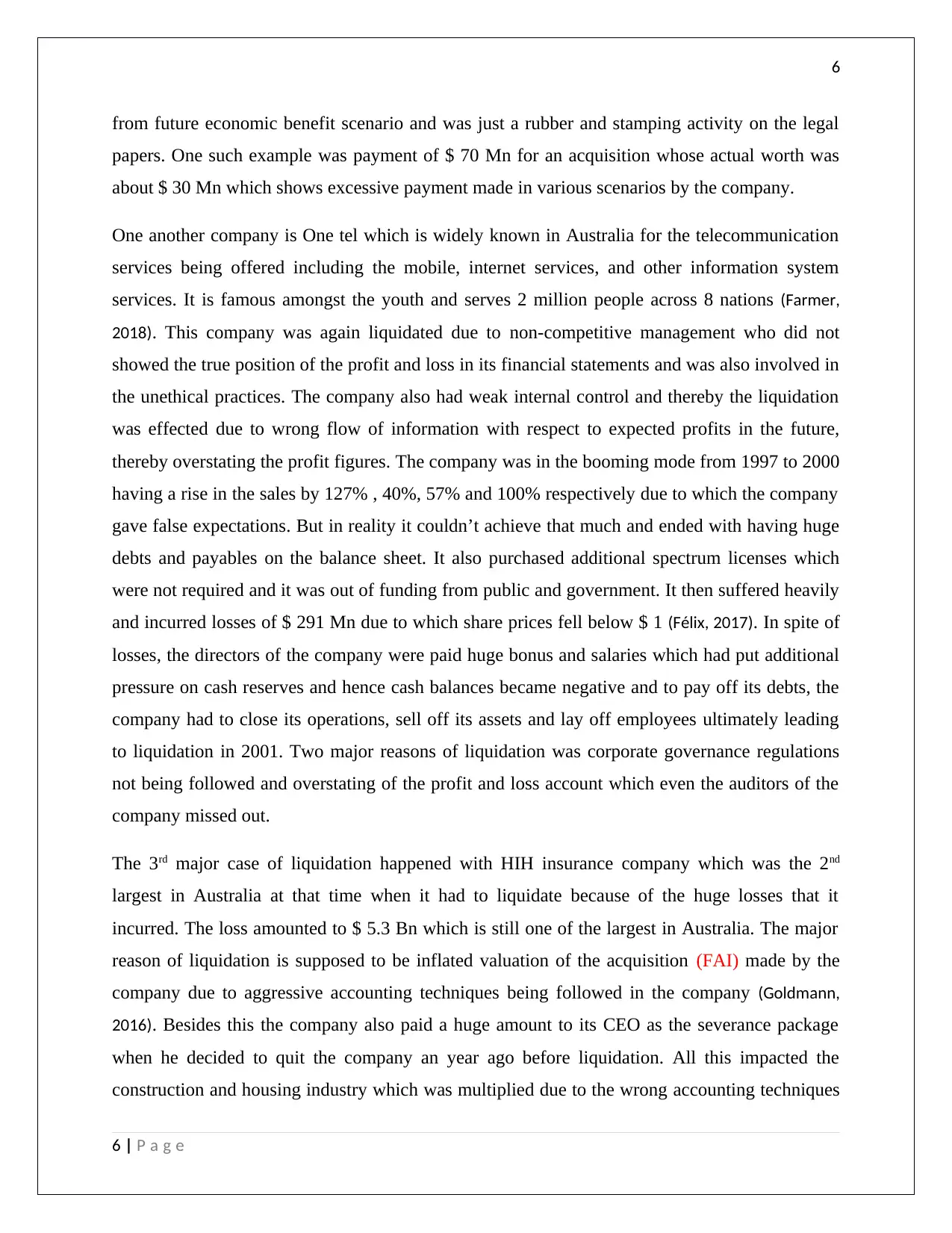
6
from future economic benefit scenario and was just a rubber and stamping activity on the legal
papers. One such example was payment of $ 70 Mn for an acquisition whose actual worth was
about $ 30 Mn which shows excessive payment made in various scenarios by the company.
One another company is One tel which is widely known in Australia for the telecommunication
services being offered including the mobile, internet services, and other information system
services. It is famous amongst the youth and serves 2 million people across 8 nations (Farmer,
2018). This company was again liquidated due to non-competitive management who did not
showed the true position of the profit and loss in its financial statements and was also involved in
the unethical practices. The company also had weak internal control and thereby the liquidation
was effected due to wrong flow of information with respect to expected profits in the future,
thereby overstating the profit figures. The company was in the booming mode from 1997 to 2000
having a rise in the sales by 127% , 40%, 57% and 100% respectively due to which the company
gave false expectations. But in reality it couldn’t achieve that much and ended with having huge
debts and payables on the balance sheet. It also purchased additional spectrum licenses which
were not required and it was out of funding from public and government. It then suffered heavily
and incurred losses of $ 291 Mn due to which share prices fell below $ 1 (Félix, 2017). In spite of
losses, the directors of the company were paid huge bonus and salaries which had put additional
pressure on cash reserves and hence cash balances became negative and to pay off its debts, the
company had to close its operations, sell off its assets and lay off employees ultimately leading
to liquidation in 2001. Two major reasons of liquidation was corporate governance regulations
not being followed and overstating of the profit and loss account which even the auditors of the
company missed out.
The 3rd major case of liquidation happened with HIH insurance company which was the 2nd
largest in Australia at that time when it had to liquidate because of the huge losses that it
incurred. The loss amounted to $ 5.3 Bn which is still one of the largest in Australia. The major
reason of liquidation is supposed to be inflated valuation of the acquisition (FAI) made by the
company due to aggressive accounting techniques being followed in the company (Goldmann,
2016). Besides this the company also paid a huge amount to its CEO as the severance package
when he decided to quit the company an year ago before liquidation. All this impacted the
construction and housing industry which was multiplied due to the wrong accounting techniques
6 | P a g e
from future economic benefit scenario and was just a rubber and stamping activity on the legal
papers. One such example was payment of $ 70 Mn for an acquisition whose actual worth was
about $ 30 Mn which shows excessive payment made in various scenarios by the company.
One another company is One tel which is widely known in Australia for the telecommunication
services being offered including the mobile, internet services, and other information system
services. It is famous amongst the youth and serves 2 million people across 8 nations (Farmer,
2018). This company was again liquidated due to non-competitive management who did not
showed the true position of the profit and loss in its financial statements and was also involved in
the unethical practices. The company also had weak internal control and thereby the liquidation
was effected due to wrong flow of information with respect to expected profits in the future,
thereby overstating the profit figures. The company was in the booming mode from 1997 to 2000
having a rise in the sales by 127% , 40%, 57% and 100% respectively due to which the company
gave false expectations. But in reality it couldn’t achieve that much and ended with having huge
debts and payables on the balance sheet. It also purchased additional spectrum licenses which
were not required and it was out of funding from public and government. It then suffered heavily
and incurred losses of $ 291 Mn due to which share prices fell below $ 1 (Félix, 2017). In spite of
losses, the directors of the company were paid huge bonus and salaries which had put additional
pressure on cash reserves and hence cash balances became negative and to pay off its debts, the
company had to close its operations, sell off its assets and lay off employees ultimately leading
to liquidation in 2001. Two major reasons of liquidation was corporate governance regulations
not being followed and overstating of the profit and loss account which even the auditors of the
company missed out.
The 3rd major case of liquidation happened with HIH insurance company which was the 2nd
largest in Australia at that time when it had to liquidate because of the huge losses that it
incurred. The loss amounted to $ 5.3 Bn which is still one of the largest in Australia. The major
reason of liquidation is supposed to be inflated valuation of the acquisition (FAI) made by the
company due to aggressive accounting techniques being followed in the company (Goldmann,
2016). Besides this the company also paid a huge amount to its CEO as the severance package
when he decided to quit the company an year ago before liquidation. All this impacted the
construction and housing industry which was multiplied due to the wrong accounting techniques
6 | P a g e
Paraphrase This Document
Need a fresh take? Get an instant paraphrase of this document with our AI Paraphraser
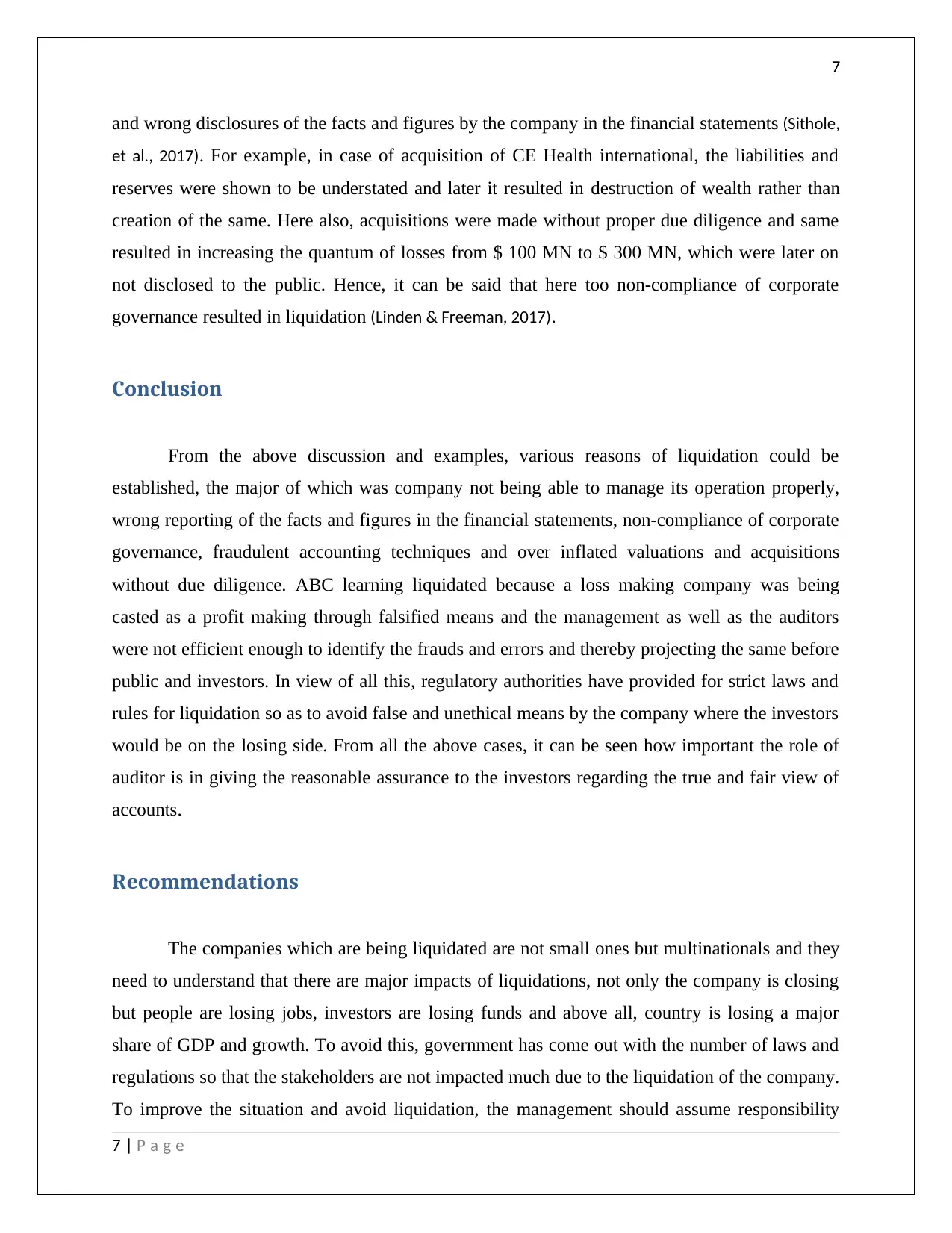
7
and wrong disclosures of the facts and figures by the company in the financial statements (Sithole,
et al., 2017). For example, in case of acquisition of CE Health international, the liabilities and
reserves were shown to be understated and later it resulted in destruction of wealth rather than
creation of the same. Here also, acquisitions were made without proper due diligence and same
resulted in increasing the quantum of losses from $ 100 MN to $ 300 MN, which were later on
not disclosed to the public. Hence, it can be said that here too non-compliance of corporate
governance resulted in liquidation (Linden & Freeman, 2017).
Conclusion
From the above discussion and examples, various reasons of liquidation could be
established, the major of which was company not being able to manage its operation properly,
wrong reporting of the facts and figures in the financial statements, non-compliance of corporate
governance, fraudulent accounting techniques and over inflated valuations and acquisitions
without due diligence. ABC learning liquidated because a loss making company was being
casted as a profit making through falsified means and the management as well as the auditors
were not efficient enough to identify the frauds and errors and thereby projecting the same before
public and investors. In view of all this, regulatory authorities have provided for strict laws and
rules for liquidation so as to avoid false and unethical means by the company where the investors
would be on the losing side. From all the above cases, it can be seen how important the role of
auditor is in giving the reasonable assurance to the investors regarding the true and fair view of
accounts.
Recommendations
The companies which are being liquidated are not small ones but multinationals and they
need to understand that there are major impacts of liquidations, not only the company is closing
but people are losing jobs, investors are losing funds and above all, country is losing a major
share of GDP and growth. To avoid this, government has come out with the number of laws and
regulations so that the stakeholders are not impacted much due to the liquidation of the company.
To improve the situation and avoid liquidation, the management should assume responsibility
7 | P a g e
and wrong disclosures of the facts and figures by the company in the financial statements (Sithole,
et al., 2017). For example, in case of acquisition of CE Health international, the liabilities and
reserves were shown to be understated and later it resulted in destruction of wealth rather than
creation of the same. Here also, acquisitions were made without proper due diligence and same
resulted in increasing the quantum of losses from $ 100 MN to $ 300 MN, which were later on
not disclosed to the public. Hence, it can be said that here too non-compliance of corporate
governance resulted in liquidation (Linden & Freeman, 2017).
Conclusion
From the above discussion and examples, various reasons of liquidation could be
established, the major of which was company not being able to manage its operation properly,
wrong reporting of the facts and figures in the financial statements, non-compliance of corporate
governance, fraudulent accounting techniques and over inflated valuations and acquisitions
without due diligence. ABC learning liquidated because a loss making company was being
casted as a profit making through falsified means and the management as well as the auditors
were not efficient enough to identify the frauds and errors and thereby projecting the same before
public and investors. In view of all this, regulatory authorities have provided for strict laws and
rules for liquidation so as to avoid false and unethical means by the company where the investors
would be on the losing side. From all the above cases, it can be seen how important the role of
auditor is in giving the reasonable assurance to the investors regarding the true and fair view of
accounts.
Recommendations
The companies which are being liquidated are not small ones but multinationals and they
need to understand that there are major impacts of liquidations, not only the company is closing
but people are losing jobs, investors are losing funds and above all, country is losing a major
share of GDP and growth. To avoid this, government has come out with the number of laws and
regulations so that the stakeholders are not impacted much due to the liquidation of the company.
To improve the situation and avoid liquidation, the management should assume responsibility
7 | P a g e
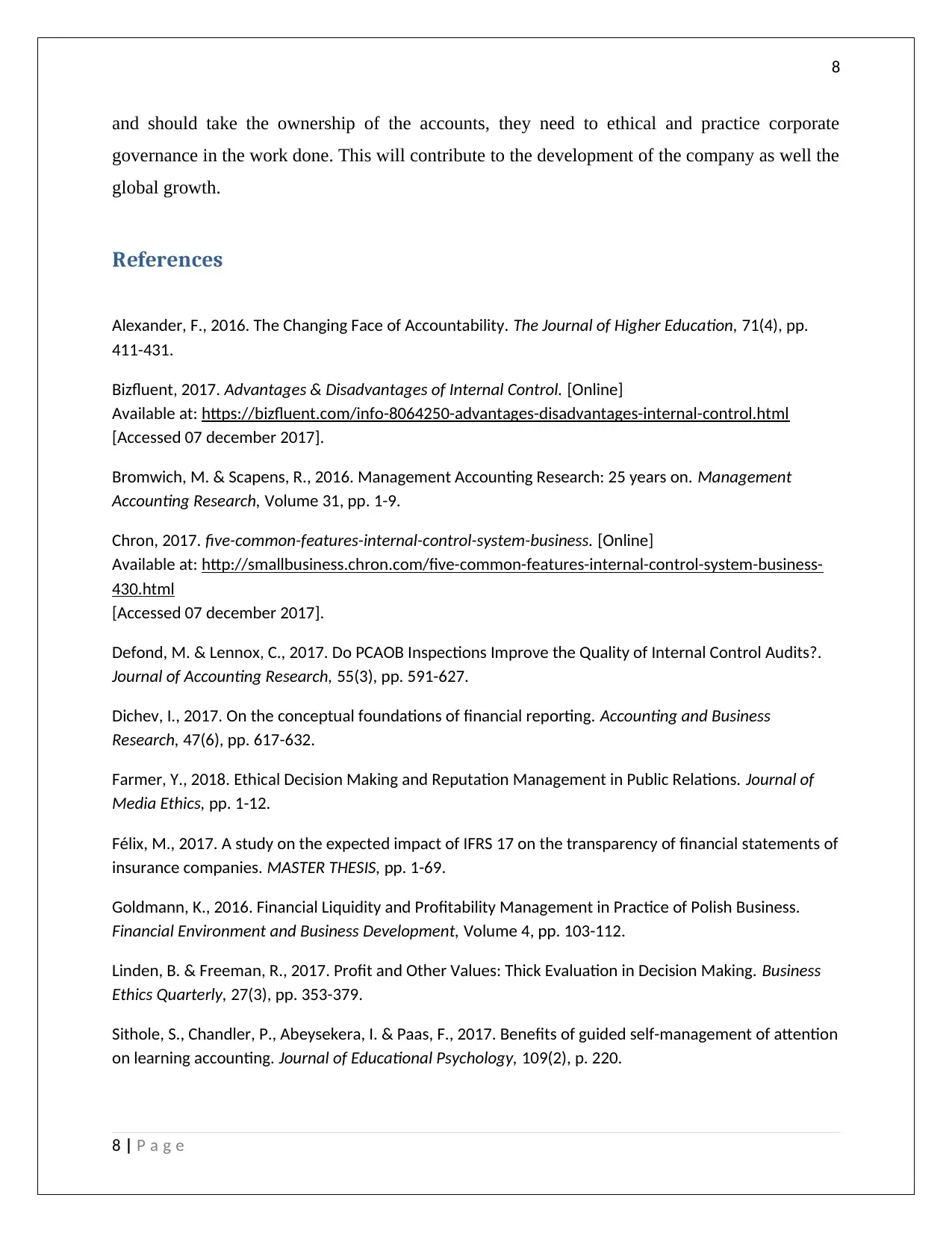
8
and should take the ownership of the accounts, they need to ethical and practice corporate
governance in the work done. This will contribute to the development of the company as well the
global growth.
References
Alexander, F., 2016. The Changing Face of Accountability. The Journal of Higher Education, 71(4), pp.
411-431.
Bizfluent, 2017. Advantages & Disadvantages of Internal Control. [Online]
Available at: https://bizfluent.com/info-8064250-advantages-disadvantages-internal-control.html
[Accessed 07 december 2017].
Bromwich, M. & Scapens, R., 2016. Management Accounting Research: 25 years on. Management
Accounting Research, Volume 31, pp. 1-9.
Chron, 2017. five-common-features-internal-control-system-business. [Online]
Available at: http://smallbusiness.chron.com/five-common-features-internal-control-system-business-
430.html
[Accessed 07 december 2017].
Defond, M. & Lennox, C., 2017. Do PCAOB Inspections Improve the Quality of Internal Control Audits?.
Journal of Accounting Research, 55(3), pp. 591-627.
Dichev, I., 2017. On the conceptual foundations of financial reporting. Accounting and Business
Research, 47(6), pp. 617-632.
Farmer, Y., 2018. Ethical Decision Making and Reputation Management in Public Relations. Journal of
Media Ethics, pp. 1-12.
Félix, M., 2017. A study on the expected impact of IFRS 17 on the transparency of financial statements of
insurance companies. MASTER THESIS, pp. 1-69.
Goldmann, K., 2016. Financial Liquidity and Profitability Management in Practice of Polish Business.
Financial Environment and Business Development, Volume 4, pp. 103-112.
Linden, B. & Freeman, R., 2017. Profit and Other Values: Thick Evaluation in Decision Making. Business
Ethics Quarterly, 27(3), pp. 353-379.
Sithole, S., Chandler, P., Abeysekera, I. & Paas, F., 2017. Benefits of guided self-management of attention
on learning accounting. Journal of Educational Psychology, 109(2), p. 220.
8 | P a g e
and should take the ownership of the accounts, they need to ethical and practice corporate
governance in the work done. This will contribute to the development of the company as well the
global growth.
References
Alexander, F., 2016. The Changing Face of Accountability. The Journal of Higher Education, 71(4), pp.
411-431.
Bizfluent, 2017. Advantages & Disadvantages of Internal Control. [Online]
Available at: https://bizfluent.com/info-8064250-advantages-disadvantages-internal-control.html
[Accessed 07 december 2017].
Bromwich, M. & Scapens, R., 2016. Management Accounting Research: 25 years on. Management
Accounting Research, Volume 31, pp. 1-9.
Chron, 2017. five-common-features-internal-control-system-business. [Online]
Available at: http://smallbusiness.chron.com/five-common-features-internal-control-system-business-
430.html
[Accessed 07 december 2017].
Defond, M. & Lennox, C., 2017. Do PCAOB Inspections Improve the Quality of Internal Control Audits?.
Journal of Accounting Research, 55(3), pp. 591-627.
Dichev, I., 2017. On the conceptual foundations of financial reporting. Accounting and Business
Research, 47(6), pp. 617-632.
Farmer, Y., 2018. Ethical Decision Making and Reputation Management in Public Relations. Journal of
Media Ethics, pp. 1-12.
Félix, M., 2017. A study on the expected impact of IFRS 17 on the transparency of financial statements of
insurance companies. MASTER THESIS, pp. 1-69.
Goldmann, K., 2016. Financial Liquidity and Profitability Management in Practice of Polish Business.
Financial Environment and Business Development, Volume 4, pp. 103-112.
Linden, B. & Freeman, R., 2017. Profit and Other Values: Thick Evaluation in Decision Making. Business
Ethics Quarterly, 27(3), pp. 353-379.
Sithole, S., Chandler, P., Abeysekera, I. & Paas, F., 2017. Benefits of guided self-management of attention
on learning accounting. Journal of Educational Psychology, 109(2), p. 220.
8 | P a g e
⊘ This is a preview!⊘
Do you want full access?
Subscribe today to unlock all pages.

Trusted by 1+ million students worldwide

9
9 | P a g e
9 | P a g e
1 out of 10
Related Documents
Your All-in-One AI-Powered Toolkit for Academic Success.
+13062052269
info@desklib.com
Available 24*7 on WhatsApp / Email
![[object Object]](/_next/static/media/star-bottom.7253800d.svg)
Unlock your academic potential
Copyright © 2020–2025 A2Z Services. All Rights Reserved. Developed and managed by ZUCOL.




